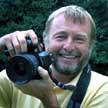I have mentioned before my frequent use of a small telephoto lens when for photographing people in real-life situations, especially when you want to remain slightly detached, yet fully able to observe the action and what is going on in front of you.
The picture here illustrates what I mean. It was taken on a 180mm f2.8 Nikkor lens. It’s worth saying that in all my travels I cannot remember when I ever carried anything longer. However, a 135mm (or equivalent) is pretty much spot-on for this type of situation when the subjects know full well that you are busy photographing them, but you do not want to get so close to them that your presence becomes obtrusive or, even worse, part of the action itself.
Beside the practicalities of handling yourself in these situations, the small telephoto lens can actually bring a real visual bonus. It can enable you to pick out selective action from the whole scene and - if you get your timing right - bring extra power and impact to your photographs. The limited depth of field of the telephoto does, of course, tend to isolate the main characters and focus your viewer’s attention on the most important aspects of the drama as it happens.
You will always run the risk when using any telephoto of having people move between you and your subject. I can be a risk well worth taking because these ‘intrusive’ elements can often add a feeling of depth, relevance and extra interest. So you must be very aware of what is happening all around you and be prepared to move quickly and decisively to either include of exclude other people.
Obviously, the main subject and focus of interest with this shot is the camel driver and the camel’s growling head. It revolves around the centre of the frame. But there are elements to left and right that add to, rather than diminish the interest of the scene. They give the impression that the action is taking place in a busy, crowded place, and that there are other people involved in the controlling of the camel. And so there were. It is an accurate portrayal of what is going on.
In my next post I’ll show you the exact opposite effect – by using a wide-angle lens during the same event.
The picture here illustrates what I mean. It was taken on a 180mm f2.8 Nikkor lens. It’s worth saying that in all my travels I cannot remember when I ever carried anything longer. However, a 135mm (or equivalent) is pretty much spot-on for this type of situation when the subjects know full well that you are busy photographing them, but you do not want to get so close to them that your presence becomes obtrusive or, even worse, part of the action itself.
Beside the practicalities of handling yourself in these situations, the small telephoto lens can actually bring a real visual bonus. It can enable you to pick out selective action from the whole scene and - if you get your timing right - bring extra power and impact to your photographs. The limited depth of field of the telephoto does, of course, tend to isolate the main characters and focus your viewer’s attention on the most important aspects of the drama as it happens.
You will always run the risk when using any telephoto of having people move between you and your subject. I can be a risk well worth taking because these ‘intrusive’ elements can often add a feeling of depth, relevance and extra interest. So you must be very aware of what is happening all around you and be prepared to move quickly and decisively to either include of exclude other people.
Obviously, the main subject and focus of interest with this shot is the camel driver and the camel’s growling head. It revolves around the centre of the frame. But there are elements to left and right that add to, rather than diminish the interest of the scene. They give the impression that the action is taking place in a busy, crowded place, and that there are other people involved in the controlling of the camel. And so there were. It is an accurate portrayal of what is going on.
In my next post I’ll show you the exact opposite effect – by using a wide-angle lens during the same event.


No comments:
Post a Comment